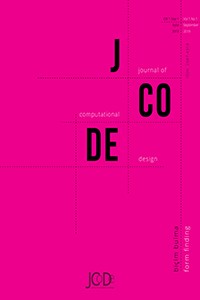Öz
This paper was produced from the master thesis titled ‘’Computing and Knitting: Experiments on Tailoring Concrete and Knitted Textile for Shell Structures‘’ that published on December 2017 in ITU Architectural Design Computing Graduate Programme. The thesis proposes an integrated design and production approach to seek future construction scenarios for the complex concrete thin shell structures by utilising material behaviour and computational tools. The investigations focus on the findings and the outcomes of the composite usage of concrete (as a compressive material) and knitted textile (as a tensile material). In the scope of this study three phased experiments were conducted, which comprised of; (i) material experiments, (ii) form finding and structural analysis, (iii)
production of physical prototypes. In order to achieve the feasible form alternatives the integration of material feedbacks from physical models and the structural feedbacks from digital model was provided. In order to get a deep understanding about the material limitations and to determine optimum cement mixture to obtain maximum mechanic behaviour from the composed material, microstructure analysis were completed in material scale.Motivated by the feasibility problems of complex concrete shells, the potentiality of initially delicate and flexible materials are explored to generate structurally efficient lightweight concrete shells in
order to eliminate the need for formwork, minimize the production cost and time by promising less labor-intensive, more sustainable and waste- free structures.
Anahtar Kelimeler
computational design structural skin concrete shell structure textile reinforced concrete cast-in-place formwork
Kaynakça
- Adriaenssens, S., Block, P., Veenendaal, D., & Williams, C. (2014). Shell structures for architecture: form finding and optimization (pp.1-5). Routledge.
- Beukers, A., & Van Hinte, E. (2005). Lightness: The inevitable renaissance of minimum energy structures, (pp.22-32). 010 Publishers.
- Bhooshan S., Van Mele T. and Block P. (2017). Equilibrium-aware shape design for concrete printing, Humanizing Digital Reality - Proceedings of the Design Modelling Symposium, 493-508. Springer Paris.
- Elmas S., & Alaçam S. (2018). Tekstil ve Betonun Biraradalığı Üzerine Deneysel Sorgulamalar. Betonart, (57), 78-83.
- Eriç, M. (2002). Yapı Fiziği ve Malzemesi. Istanbul: Literatür Yayıncılık.
- Kolarevic, B., & Klinger, K. (2008). Manufacturing material effects: rethinking design and making in architecture. Routledge s.103-118.
- Lloret, E., Shahab, A. R., Linus, M., Flatt, R. J., Gramazio, F., Kohler, M., & Langenberg, S. (2015). Complex concrete structures: Merging existing casting techniques with digital fabrication. Computer-Aided Design, 60, 40-49.
- Van Mele, T., & Block, P. (2011). A novel form finding method for fabric formworkfor concrete shells. J. Int. Assoc. Shell and Spatial Structures, 52(217224), 31.
- Veenendaal, D., & Block, P. (2012). 35 Computational form-finding of fabricformworks : an overview and discussion. Proceedings of the 2nd International Conference on Flexible Formwork.University of Bath.
- Url 1 <http://gramazio-kohler.arch.ethz.ch/web/e/forschung/164.html>
- Url 2 <http://adapa.dk>
- Url 3 <http://www.block.arch.ethz.ch/brg/project/full-scale-construction-prototype-nest- hilo-shell-roof>
Öz
Bu yazı Aralık 2017’ de İTÜ Mimari Tasarımda Bilişim Lisansüstü Programı’nda yayınlanan ‘’Computing and Knitting: Experiments on Tailoring Concrete and Knitted Textile for Shell Structures‘’ başlıklı tezden üretilmiştir. Tezde, karmaşık biçimlerdeki beton kabuk strüktürlerin üretilebilirliği üzerine malzeme özelliklerinden ve hesaplamalı tasarım araçlarından yararlanarak geliştirilen bütünleşik bir tasarım ve üretim yaklaşımı önerilmektedir. Araştırmada, beton ve örülmüş tekstilin kompozit kullanımı sırasında elde edilen bulgular ve çıktılar üzerine odaklanılmıştır. Başlangıçta esnek ve kolay biçimlenebilen bir malzemeden yararlanmak hedeflenirken, farklı bir kalıba gerek duyulmadan rijit bir strüktürel davranış gösteren hafif beton kabuk oluşturmanın potansiyelleri ele alınmıştır. Çalışma kapsamında yapılan deneyler, malzeme deneyleri, biçim arayışı-dijital simülasyonlar ve fiziksel prototip üretimi olmak üzere üç ana başlık altında toplanmıştır. Mikro ölçekte yapılan malzeme deneyleri üzerinden strüktürel davranışın iyileştirilmesi hedeflenirken aynı zamanda oluşturulan parametrik model ile form arayışının da strüktürel geri dönüşlerle süreç içinde beslenmesi sağlanmıştır. Önerilen yöntem ile, beton kabuk strüktür uygulamalarında kalıp ihtiyacı egale edilerek, üretim maliyetinin, üretim süresinin ve yoğun emek gerektiren işçiliğin minimize edilmesi ile malzeme kaynaklarının sorumlu bir şekilde kullanılması ve üretim kaynaklı atık miktarının
sıfırlanması hedeflenmiştir.
Anahtar Kelimeler
hesaplamalı tasarım strüktürel kabuk beton kabuk yapısı tekstil betonarme yerinde dökme kalıp
Kaynakça
- Adriaenssens, S., Block, P., Veenendaal, D., & Williams, C. (2014). Shell structures for architecture: form finding and optimization (pp.1-5). Routledge.
- Beukers, A., & Van Hinte, E. (2005). Lightness: The inevitable renaissance of minimum energy structures, (pp.22-32). 010 Publishers.
- Bhooshan S., Van Mele T. and Block P. (2017). Equilibrium-aware shape design for concrete printing, Humanizing Digital Reality - Proceedings of the Design Modelling Symposium, 493-508. Springer Paris.
- Elmas S., & Alaçam S. (2018). Tekstil ve Betonun Biraradalığı Üzerine Deneysel Sorgulamalar. Betonart, (57), 78-83.
- Eriç, M. (2002). Yapı Fiziği ve Malzemesi. Istanbul: Literatür Yayıncılık.
- Kolarevic, B., & Klinger, K. (2008). Manufacturing material effects: rethinking design and making in architecture. Routledge s.103-118.
- Lloret, E., Shahab, A. R., Linus, M., Flatt, R. J., Gramazio, F., Kohler, M., & Langenberg, S. (2015). Complex concrete structures: Merging existing casting techniques with digital fabrication. Computer-Aided Design, 60, 40-49.
- Van Mele, T., & Block, P. (2011). A novel form finding method for fabric formworkfor concrete shells. J. Int. Assoc. Shell and Spatial Structures, 52(217224), 31.
- Veenendaal, D., & Block, P. (2012). 35 Computational form-finding of fabricformworks : an overview and discussion. Proceedings of the 2nd International Conference on Flexible Formwork.University of Bath.
- Url 1 <http://gramazio-kohler.arch.ethz.ch/web/e/forschung/164.html>
- Url 2 <http://adapa.dk>
- Url 3 <http://www.block.arch.ethz.ch/brg/project/full-scale-construction-prototype-nest- hilo-shell-roof>
Ayrıntılar
| Birincil Dil | Türkçe |
|---|---|
| Konular | Yazılım Testi, Doğrulama ve Validasyon, Mimarlık |
| Bölüm | Araştırma Makaleleri |
| Yazarlar | |
| Yayımlanma Tarihi | 30 Eylül 2019 |
| Yayımlandığı Sayı | Yıl 2019 Cilt: 1 Sayı: 1 |

JCoDe makaleleri "Creative Commons Attribution-NonCommercial 4.0 International License" altında yayınlanmaktadır.


